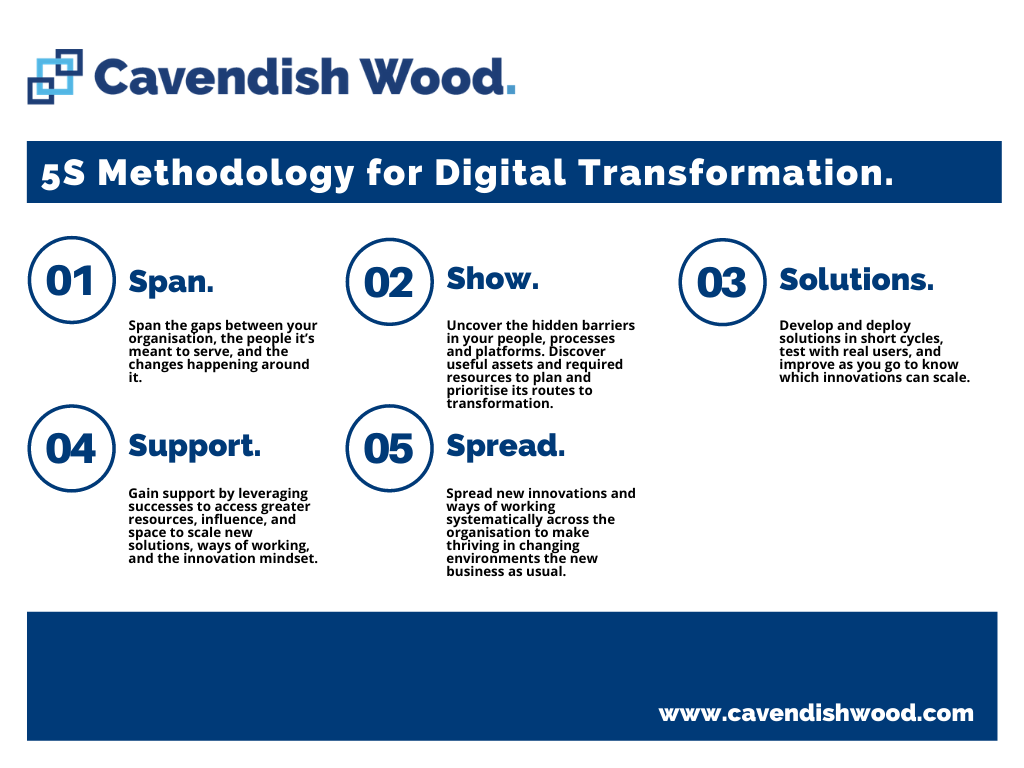
Digital transformation is ubiquitous across local government at every level, as organisations look to deliver improved, modern services to the residents and business in their constituencies.
Local authorities face increased public demand for services, combined with ever-present budgetary pressure. So, putting digital to work correctly in local government means:
- creating modernised and more relevant services.
- transforming the organisation to enable a sustainable digital delivery culture.
- flushing out and delivering tangible and significant savings throughout the organisation.
The 5S Methodology for Digital Transformation.
At Cavendish Wood, we use a bespoke methodology called “The 5S Methodology for Digital Transformation”, which we developed through working closely with local government organisations. Over the next few weeks, I will be deep-diving into each phase of the methodology to discuss some of the critical objectives, tools, and techniques to transform your local authority successfully.
SKIP TO ALL STAGE EXPLANATIONS:
Why digital transformation fails in local government.
Before getting into the first phase, it’s worth a quick discussion about why digital transformations fail or don’t seem to deliver the value expected. Local authorities are complex, vertically siloed organisations providing many disparate services to a diverse range of residents and businesses. These factors make the digital transformation of local government a significantly tricky undertaking. It is made more challenging by several common characteristics across the sector, combined with the complexities unique to specific organisations.

Local government organisations operate under extreme budget pressure. Therefore, there must be a solid business case behind every investment, which is difficult to achieve due to the very nature of digital change and how an organisation must adapt to achieve meaningful transformation.
Organisational culture in local government is often traditional in nature, with long-standing staff, systems, processes, and business models that must be challenged to build a sustainable and constant digital change culture. I often see the IT team driving digital change, which doesn’t work. IT cannot transform the business.
As stated above, digital transformation is a term ubiquitous in nearly every organisation. Indeed, within every local authority in the UK, programmes and initiatives are underway to deliver digital change. Simply digitising existing processes and services doesn’t constitute digital transformation. There are three critical objectives for a local authority to achieve transformation. The first two are constant and will become objectives for the organisation to strive towards on an ongoing basis. The third objective is what we define as digital transformation in the most real sense:
- To deliver modern, accessible services aligned to customer expectations and the external technology and regulatory landscape.
- To put digital to work effectively to generate savings and efficiencies.
- To transform the organisation to remain aligned with customer expectations and the external technology and regulatory landscape.
The digital strategy in play at many local authorities is often more about technology transformation than digital transformation. New technology cannot deliver new ways of working, digital delivery capability, and without a genuine shift in culture, it won’t improve the customer experience or enable any savings. In fact, it is usually the opposite. Technology costs money, and if that’s all you get, it’s just a cost.
Having the right strategy in place is critical to building accountability and encouraging momentum. An IT strategy or a technology roadmap does not do this.
Almost all aspects of council services depend on some form of technology components, whether these are mobile tools, cloud apps, cybersecurity, social media tools, or detailed data analytics. Although supporting these is an IT function, the tools need to be understood, led, and owned by service leaders because they impact the whole organisation’s efficiency.
Span.
The first phase of transformation and the first of the five S’ is “Span”. Before you dive headlong into digital transformation, there are some key things you need to do and understand.
The key objectives of Span are:
- Span the internal and external gaps
- Define a Shared Vision for Transformation
- Appoint a Leadership Team
Initially, and as the name implies, this phase is all about spanning gaps:
- External gaps between your organisation and the outside world.
The real solutions to your organisation’s digital transformation are outside, not in a conference room. This phase is about spanning those gaps, connecting with customers and partners to understand what needs to be changed and how quickly.
- Internal gaps between your business units, hierarchies, and silos.
How do gaps form?
The very fact that you know that you need digital transformation at your local authority is evidence that gaps have formed between your internal organisation, technology and processes and the external technology landscape and the very people you are here to serve.

The gaps have formed because external digital change has happened much more rapidly than your organisation could keep pace with. Digital change has changed your customers’ expectations, often leaving you delivering very outdated, legacy services. These gaps mean that however much you brainstorm and develop ideas, you do not have the information you need internally to define a strategy based on anything meaningful.
Digitally mature organisations have an outward-facing orientation, meaning that they deliver solutions based on what they know their users need, not what they think they need. They also utilise technology that their peers and competitors are using to generate positive customer experiences.
Internal gaps are formed over long periods as the organisation strives for systems of standardisation and hierarchical control. Layers of management and silos compound this to isolate senior leadership from the customer’s real wants and needs and what is happening at the organisation’s customer-facing level. The result is leaders who struggle to make collective decisions.
How to Span.
To Span successfully, you need to form genuine connections both outside and inside your organisation. These are connections with customers, peers from other local authorities, strategic partners and suppliers. The connections must be permanent and remain well after the initial phase is complete. Otherwise, the gaps will re-open.
The critical outputs of these connections are tangible evidence relating to:
- What your customers need and want
- If your current service delivers what it promises
- If your current service is what your customers need
You need to ask:
- What has changed since your current service infrastructure and process was defined?
- What experiences are of more value to your customers both from the public and private sectors?
- What aspects of this preferred experience can you utilise to deliver better service to your customers?
You cannot do this research by looking inwards. You must go outside of your organisation for the answers. There are numerous methods of doing this, but essentially it boils down to talking to your customers, peers and suppliers to get the information required for the next step in this phase, defining a “Shared Vision for Transformation”.
What is a “Shared Vision for Transformation”?
Digital Transformation does not need a detailed strategy document. Conceptually, this is often difficult to accept given the importance and complexity of the task ahead. Still, the nature of digital change means that the strategy (or “Shared Vision for Transformation”) should be a living construct, updated as soon as new insights or external change requires it to be.

Shared, in the sense that it is created collaboratively and shared in the sense that it is shared across the entire organisation, becoming the set of principles that drive every digital change piece. The organisation should live and breathe this vision.
So it needs to be a concise set of statements that articulate the current position, what needs to change and why. Effective shared visions typically focus on as few as five key goals. These statements must come from research undertaken during the first phase of transformation and mitigate the gaps between your organisation, the people you exist to serve and the external technology environment. You must also focus on internal gaps between silos, departments and business units.
An example statement could be as follows:
Today.
“Our customers often need to interact with many different departments across the organisation. Each time they do this, they are treated as new customers and are required to give a large amount of contact and personal information. This ordeal creates poor experience and creates inefficiency. Furthermore, we have no clear picture of the touchpoints across the organisation for each customer or the overall demand for each service.”
“The council has many different customer data sources, some of which are only known to the departments that keep them. This data is often not secure, internally unregulated and cannot be used to gain customer insights which could enable service improvements, opportunities for revenue generation, or creating internal efficiencies.”
Our vision for transformation.
“Customer data should be collected and stored once at first contact only and be available to any department across the organisation that require it, to create a more positive customer experience and save time and costs.”
How to develop a shared digital transformation vision.
Regardless of the current status of your council’s digital transformation programme, it’s never too late to develop a shared vision between crucial personnel who can drive the programme forward. To do this, you’ll need to identify gaps within the organisation that prevent your organisation from adapting to external changes and the progressing needs of your customers. If those gaps didn’t exist and your organisation was founded today, how would you deliver to those external needs and conditions?
Using the methods described earlier to form external connections is critical to define a worthwhile vision for transformation that the organisation can stand behind.
Building buy-in.
Developing a shared vision of digital transformation that your key players can buy into also requires you to understand each of the stakeholders’ personal goals and motivations. You need to include the most senior people in your team and get them to help you shape a draft vision that they can endorse. In turn, this will allow you to build the buy-in you need for success.

Remember, some of your key staff might be more competitive than others, so their input could be biased towards improving their own team’s success before the broader organisation. Encourage key players to step up and lead the transformation.
Skipping the tech talk.
Avoid talking about the actual technology. That tends to result in getting bogged down in discussions about hardware and software that exist currently. Instead of merely tweaking what is already available, you want to transform the council’s way of working, come up with new customer engagement models, and open up the possibilities of developing programs that can provide a new way forward.
Getting agreement.
When you get all your key workers to agree in principle on the broad outline of a vision that they understand and value, the council will head for successful transformation in the long term. This process takes years, not a few months, and its basis is on clear benefits to everyone internally and externally. To achieve it, you’ll need to set high expectations that will keep your people continually motivated and give them the incentives they need to do the work required.
Appointing the right leaders.
As with any significant undertaking, you’ll need to appoint the right leadership for your project. Driving digital transformation should be from the top down. As with any major programme, you need a leadership group responsible for starting it, guiding it and ensuring its success. This is especially true for digital transformation because of the cross-functional nature of the work.

The leadership group will be needed to ensure resources and budget are available and to remove barriers that are often caused by other senior leaders.
The group should consist of sponsors, champions, and a change agent/programme director. I recommend establishing a Digital Portfolio Office (DPO) to achieve this.
The DPO should include the Chief Executive as the sponsor, the existing Digital Leadership Team and others as champions, and a programme director.
The roles are discussed below:
- Sponsor – The person with sufficient seniority, power, and resources to fund and propel transformation efforts. Ideally, this is the organisation’s leader, though it can be senior executives or board members, provided they have sufficient influence and budget control.
- Champions – People in senior leadership and influential positions who are also hungry to change can contribute time, resources and influence from their perspective areas. This group are the programme’s advocates, and the areas of the business they control are the perfect area to trial new projects, ideas and ways of working.
- Change Agent/Programme Director – The person ultimately accountable and responsible for leading projects within the programme and achieving the shared vision for transformation. The change agent is the key decision-maker responsible for driving the digital transformation agenda. Their professional reputation should rest on the transformation’s success or failure within the council.
The change agent is the most critical person within the digital leadership group, and they have a particular role. Being technical is not a prerequisite. In fact, in many cases, it is best that they are not a technical specialist. Instead, this person must have:
- The right level of seniority to effect change at the senior leadership level
- Be capable of inspiring others to invest their time and collaborate outside of traditional structures to complete initiatives that one department could never do alone.
Now What?
Armed with your Shared Vision for Transformation and a committed and focussed leadership group, you can move to the next transformation phase. The next step in the 5S Methodology for Digital Transformation – “Show” is where you will uncover and prioritise the first projects that transformation should take on by flushing out barriers to transformation in your people, processes and platforms, and finding assets to leverage and build on.
SKIP TO ALL STAGE EXPLANATIONS:


